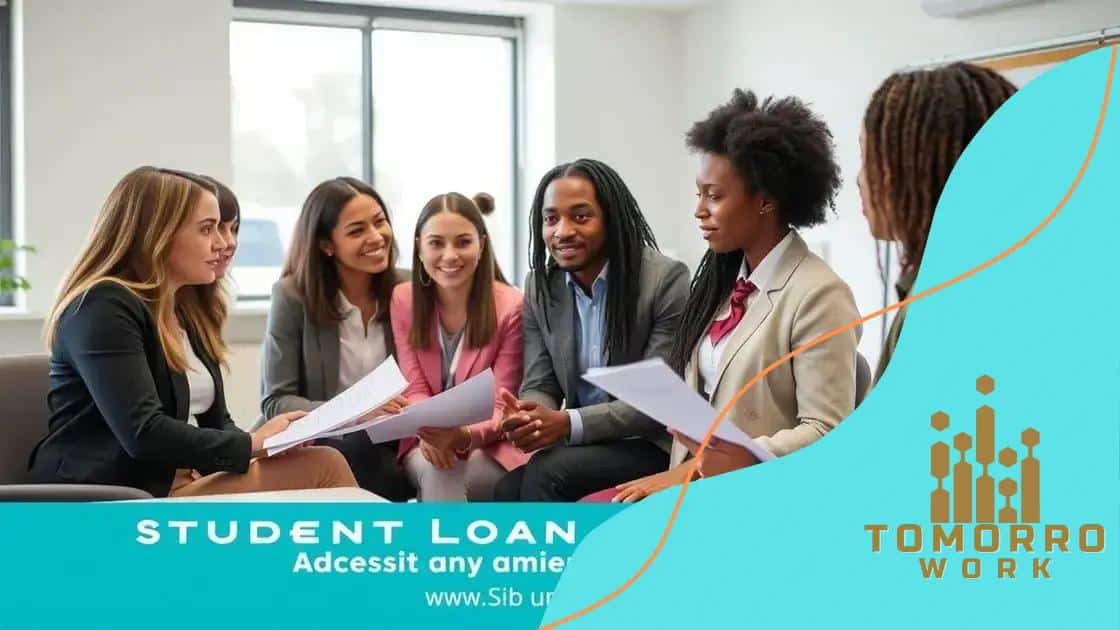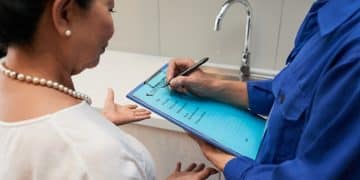Federal student loan forgiveness programs for non-profit workers

Advertisements
Federal student loan forgiveness programs for non-profit workers provide opportunities to eliminate debt after meeting specific eligibility requirements, including qualifying employment and consistent loan payments.
Federal student loan forgiveness programs for non-profit workers can significantly ease the financial strain of student debt. Are you aware of the options available to you? Let’s dive into the possibilities.
Advertisements
Understanding federal student loan forgiveness
Understanding federal student loan forgiveness can be a game-changer for many individuals working in non-profit organizations. Many people don’t realize how these programs work and how they can benefit their financial situation. In this section, we’ll break down the basics and help you grasp the key elements of these programs.
What is federal student loan forgiveness?
Federal student loan forgiveness programs are designed to help borrowers reduce or eliminate their student loan debts. These programs offer various options based on the type of employment you have and the loan repayment plan you follow.
How does it work?
To qualify for forgiveness, you generally need to make consistent payments on your loans while working in a qualifying job, such as at a non-profit organization or a government agency. The types of loans and repayment plans also play a significant role in your eligibility.
Advertisements
- You must be employed full-time by a qualifying employer.
- Payments made under qualifying repayment plans count toward forgiveness.
- After a specific number of qualifying payments, the remaining balance may be forgiven.
- Different programs have unique requirements and benefits.
It’s crucial to stay informed about the terms and conditions set forth by the various forgiveness programs. They can differ significantly, and understanding them can make a substantial difference in your repayment strategy.
Types of forgiveness programs
There are several programs available specifically for non-profit workers, such as the Public Service Loan Forgiveness (PSLF) program. This particular program forgives the remaining loan balance after 120 qualifying payments under a qualifying repayment plan.
Importance of understanding eligibility
Knowing the eligibility criteria is essential. For many, this knowledge opens doors to financial relief that they might not have thought possible. Being aware of the varying requirements helps you to navigate the application process with confidence.
Many organizations offer resources to help you determine your eligibility and guide you through the application process. Accessing these resources can provide clarity and support in understanding federal student loan forgiveness programs.
Eligibility requirements for non-profit workers
Eligibility requirements for non-profit workers can vary based on the specific forgiveness programs available. Understanding these requirements is essential for taking advantage of federal student loan forgiveness options.
General eligibility criteria
To qualify, borrowers typically need to meet certain conditions. You must be employed full-time at a non-profit organization or a government agency to be eligible for many forgiveness programs.
- You should work in a job that serves the public interest.
- Your employment must be with a qualifying employer, such as a 501(c)(3) organization.
- Maintain a position for a specific number of years to qualify for loan forgiveness.
While general criteria are similar across programs, specific rules may differ. It’s crucial to check the details of each program.
Understanding qualifying loans
Another important factor is that not all federal student loans qualify for forgiveness. Typically, only Direct Loans are eligible unless they are consolidated into a Direct Consolidation Loan.
Additionally, you must be on a qualifying repayment plan to ensure that your payments count toward forgiveness. The Income-Driven Repayment plans are popular choices among non-profit workers.
Documenting your employment
Documentation is also vital. To prove your qualifying employment, you may need to submit an Employment Certification Form regularly. This form helps track your progress and ensure that you are on the right path toward forgiveness.
Non-profit organizations can often provide assistance in understanding these documentation requirements. Engaging with your employer can help streamline this process.
Staying informed
Staying updated on changes in eligibility requirements is essential because they can change from year to year. Following official resources and guidance can help you navigate the process effectively. Participating in workshops or webinars can also enhance your understanding of eligibility criteria and how to meet them.
Types of forgiveness programs available

There are various types of forgiveness programs available for those in non-profit jobs, and understanding each one is key to maximizing your benefits. These programs vary by their requirements and eligibility criteria.
Public Service Loan Forgiveness (PSLF)
The most well-known program is the Public Service Loan Forgiveness (PSLF). This program forgives the remaining balance on Direct Loans after the borrower makes 120 qualifying monthly payments under a qualifying repayment plan while working full-time for a qualifying employer.
- Must have Direct Loans.
- Payments should be made under an Income-Driven Repayment plan.
- Employed by a non-profit or government organization.
It’s essential to submit the Employment Certification Form annually and keep track of your payments to ensure they count toward forgiveness.
Teacher Loan Forgiveness
The Teacher Loan Forgiveness program is specifically for teachers who work in low-income schools. This program offers forgiveness up to $17,500 for eligible teachers.
To qualify, teachers must have worked for five consecutive years in a designated low-income school. This program requires similar documentation but focuses on the teaching profession.
Income-Driven Repayment Plan Forgiveness
Income-Driven Repayment plans can lead to forgiveness after 20 or 25 years of qualifying payments. Under these plans, your payments are based on your income and family size, making them manageable for many non-profit workers.
National Health Service Corps (NHSC) Loan Repayment Program
This program is aimed at healthcare professionals who work in underserved areas. The NHSC provides loan repayment assistance to those who commit to serving in high-need locations for two years.
Participants can receive up to $50,000 to pay down their student loans after completing their service obligation. This program highlights the commitment to public health and supports professionals in making a difference.
State-Specific Forgiveness Programs
Many states have their own loan forgiveness programs that target specific professions, such as nursing, social work, and public defenders. These programs can vary widely, so it’s essential to research what’s available in your state.
Each program has different eligibility criteria, application processes, and forgiveness amounts. Knowing about these options helps you make informed decisions about your loans.
Application process for forgiveness
The application process for forgiveness can seem daunting, but understanding the steps can help you navigate it with more confidence. Applying for federal student loan forgiveness programs typically involves several key steps.
Gather Necessary Documents
Before starting your application, gather all necessary documents. This may include your loan information, proof of employment, and any relevant financial documents. Having this information ready will streamline the process.
- Your loan account numbers.
- Pay stubs or proof of income.
- Employment Certification Forms for every qualifying employer.
It’s crucial to ensure you have complete and accurate documentation to avoid delays.
Complete the Application Form
After gathering your documents, the next step is filling out the correct application form. For most forgiveness programs, you’ll need to complete the Employment Certification Form. This form confirms your employment status and qualifies your job type.
Submit Your Application
With the application form completed, you can submit it to your loan servicer. Make sure to keep copies of everything you send in for your records. Submitting your application can often be done online through your loan servicer’s website.
Follow Up on Your Application
After submitting your application, it’s a good practice to follow up. Contact your loan servicer to confirm the receipt of your application and inquire about the timeline for processing. Waiting for a decision can sometimes feel lengthy, but regular check-ins can provide peace of mind.
Keep Records of Your Payments
Throughout the repayment period, keep accurate records of your payments. This tracking is crucial for ensuring that you meet the minimum payment requirements for forgiveness. Consider saving bank statements or payment confirmations, as they may be requested later.
Remember, understanding how to properly apply for forgiveness can lessen the stress of the process. By following these steps carefully and staying organized, you can navigate the application process effectively.
Common challenges and solutions
When navigating federal student loan forgiveness programs, borrowers often face several common challenges. Understanding these challenges and their solutions can help you successfully manage the process and ease your burden.
Challenge: Confusing Eligibility Requirements
Many applicants struggle with the eligibility requirements for different forgiveness programs. Each program has specific criteria that must be met, leading to confusion and potential disqualification.
- Research each program’s requirements to ensure you know what’s needed.
- Contact your loan servicer for clarification on any points you don’t understand.
- Consider joining webinars or workshops that explain the eligibility criteria in detail.
By staying informed, you can avoid misunderstandings that could hinder your application.
Challenge: Incomplete Documentation
Another common problem is submitting incomplete or inaccurate documentation. Essential documents include employment verification and proof of qualifying payments. Missing these can delay your application.
To combat this, create a checklist of required documents and regularly verify that all pieces are complete. Additionally, keeping digital copies of your documents can ensure that you have them ready when needed.
Challenge: Long Processing Times
After applying, many borrowers experience long wait times for processing and approval. This can be frustrating and lead to uncertainty about your financial future.
To manage this, maintain contact with your loan servicer. Regular follow-ups can help you stay updated on your application status. Also, exploring alternative repayment options during this waiting period can ease financial pressure.
Challenge: Changes in Program Requirements
Occasionally, federal student loan forgiveness programs can undergo changes that affect eligibility or benefits. This can leave borrowers feeling uncertain about their status.
It’s crucial to regularly check official sources, such as the Federal Student Aid website, for updates. Being proactive about changes in the law can help you adapt quickly and secure your benefits.
Having strategies in place for these challenges not only prepares you for the application process but also empowers you to feel more in control of your financial situation.
FAQ – Frequently Asked Questions about Federal Student Loan Forgiveness Programs
What is the Public Service Loan Forgiveness program?
The Public Service Loan Forgiveness program forgives the remaining balance on Direct Loans after you make 120 qualifying payments while working for a qualifying employer.
How do I know if I qualify for loan forgiveness?
Qualification depends on factors like employment type, loan type, and repayment plan. It’s important to review the specific eligibility criteria for each forgiveness program.
What documents do I need to apply for forgiveness?
You will typically need proof of employment, payment history, and an Employment Certification Form completed by your employer.
How long does the loan forgiveness process take?
The processing time can vary, but after you submit your application, it can take several months to receive a decision. Following up regularly with your loan servicer can help.





